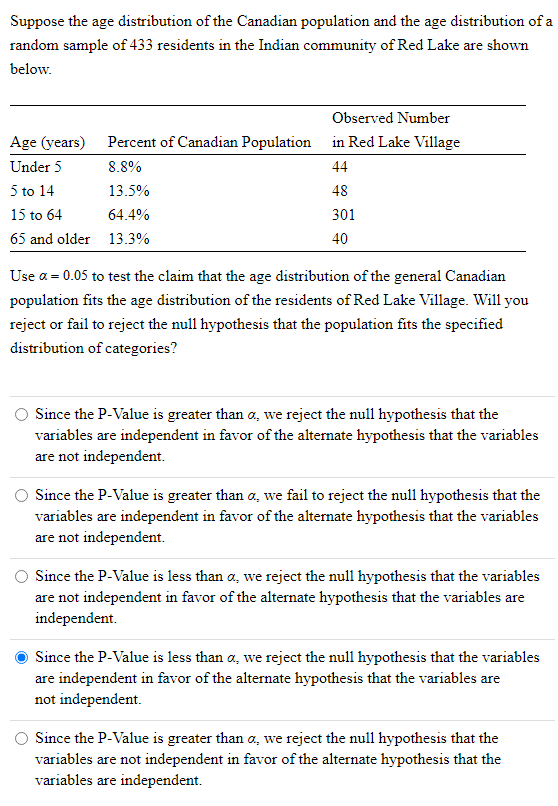Suppose the age distribution of the Canadian population and the age distribution of a random sample of 433 residents in the Indian community of Red Lake are shown below. Use 0.05 level of significance to test the claim that the age distribution of the general Canadian population fits the age distribution of the residents of Red Lake Village. Will you reject or fail to reject the null hypothesis that the population fits the specified distribution of categories?
Suppose the age distribution of the Canadian population and the age distribution of a random sample of 433 residents in the Indian community of Red Lake are shown below. Use 0.05 level of significance to test the claim that the age distribution of the general Canadian population fits the age distribution of the residents of Red Lake Village. Will you reject or fail to reject the null hypothesis that the population fits the specified distribution of categories?
Glencoe Algebra 1, Student Edition, 9780079039897, 0079039898, 2018
18th Edition
ISBN:9780079039897
Author:Carter
Publisher:Carter
Chapter10: Statistics
Section10.4: Distributions Of Data
Problem 19PFA
Related questions
Question
Suppose the age distribution of the Canadian population and the age distribution of a random sample of 433 residents in the Indian community of Red Lake are shown below.
Use 0.05 level of significance to test the claim that the age distribution of the general Canadian population fits the age distribution of the residents of Red Lake Village. Will you reject or fail to reject the null hypothesis that the population fits the specified distribution of categories?

Transcribed Image Text:Suppose the age distribution of the Canadian population and the age distribution of a
random sample of 433 residents in the Indian community of Red Lake are shown
below.
Observed Number
Age (years) Percent of Canadian Population in Red Lake Village
Under 5
8.8%
44
5 to 14
13.5%
48
15 to 64
64.4%
301
65 and older 13.3%
40
Use a = 0.05 to test the claim that the age distribution of the general Canadian
population fits the age distribution of the residents of Red Lake Village. Will you
reject or fail to reject the null hypothesis that the population fits the specified
distribution of categories?
Since the P-Value is greater than a, we reject the null hypothesis that the
variables are independent in favor of the alternate hypothesis that the variables
are not independent.
Since the P-Value is greater than a, we fail to reject the null hypothesis that the
variables are independent in favor of the alternate hypothesis that the variables
are not independent.
Since the P-Value is less than a, we reject the null hypothesis that the variables
are not independent in favor of the alternate hypothesis that the variables are
independent.
Since the P-Value is less than a, we reject the null hypothesis that the variables
are independent in favor of the alternate hypothesis that the variables are
not independent.
Since the P-Value is greater than a, we reject the null hypothesis that the
variables are not independent in favor of the alternate hypothesis that the
variables are independent.
Expert Solution
This question has been solved!
Explore an expertly crafted, step-by-step solution for a thorough understanding of key concepts.
This is a popular solution!
Trending now
This is a popular solution!
Step by step
Solved in 2 steps

Knowledge Booster
Learn more about
Need a deep-dive on the concept behind this application? Look no further. Learn more about this topic, statistics and related others by exploring similar questions and additional content below.Recommended textbooks for you

Glencoe Algebra 1, Student Edition, 9780079039897…
Algebra
ISBN:
9780079039897
Author:
Carter
Publisher:
McGraw Hill

Glencoe Algebra 1, Student Edition, 9780079039897…
Algebra
ISBN:
9780079039897
Author:
Carter
Publisher:
McGraw Hill